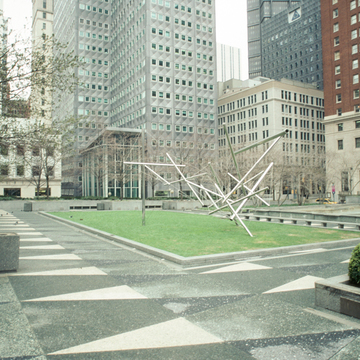The ALCOA (Aluminum Company of America) building is one of the architectural icons of post–World War II America. The integration of windows within their spandrels, the simplicity of bolting the aluminum panels on their frames, the ease of cleaning the swivel windows, and the broad internal corridors that served as impromptu conference centers were all innovations that were supposed to forever change the art of building skyscrapers. Instead, ALCOA's influence was muted, and aluminum-clad office towers remain a rarity. The ALCOA corporation itself left the building in 1998 for a low-rise of a radically different configuration on the Allegheny shore (AL66). The thirty-story tower and its striking glass-walled entrance pavilion now house a consortium of city and regional planning agencies that hope to emulate the postwar synergy of Pittsburgh's Renaissance I.
Mellon Square was conceived to highlight ALCOA, to the north, and Mellon Bank, to the south, as two crown jewels of the Mellon empire. It still bespeaks the community spiritedness of cousins Paul and Richard King Mellon, who financed the project, and the ingenuity of the architects and landscape designers in consolidating a parking garage, fringe of retail stores, cascading fountain, and ample space for lunchtime patrons.


